This time we made a stress test of an inexpensive slide phone Samsung C3050. The box the device comes in (pic. 1), the accessories (pic. 2) and the functions of this gadget do not differ much from the other low-cost cell phones. Have a look at the C3050 (pic. 3, 4). A 5-positional key is made of plastic with a ribbed cover. The other keys of the navigational key unit have a steel cover. The lower and the upper edges of the handset are covered with grey paint. It seems that the phone is made of a low quality plastic material and it feels shaggy. But we thought that this feature could make it more durable than the other phones of the same price range.
Results
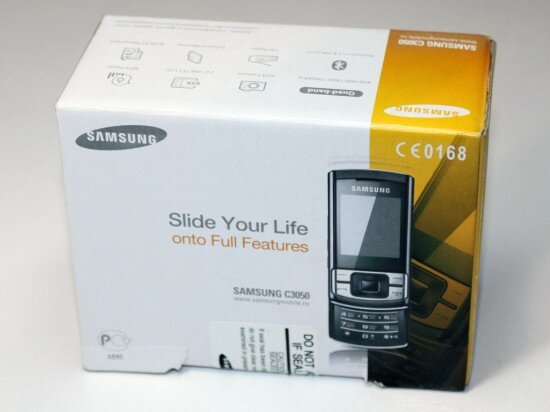
- Pic. 1. Delivery box
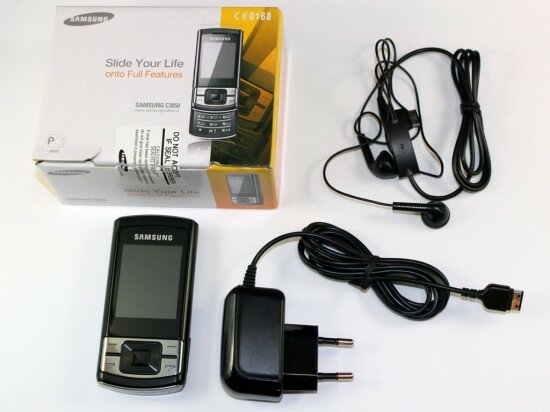
- Pic. 2. Accessories
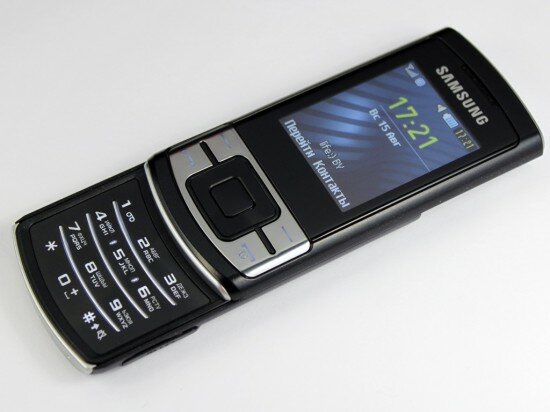
- Pic. 3. Front side
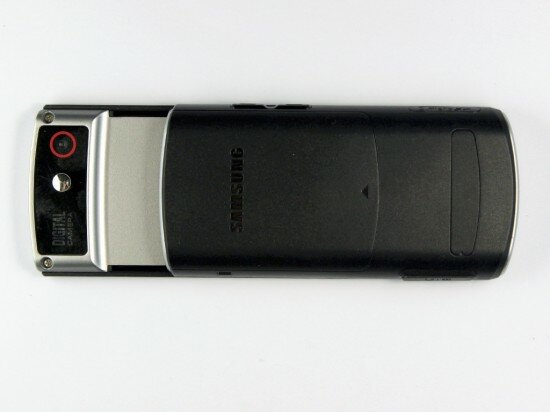
- Pic. 4. Back side
1. Samsung C3050 stress test. Stage 1 – Light shocks
1.1 Drop test
According to our tradition we started the experiment with a drop test. We sequentially dropped the C3050 onto each face, edge and corner from 1 m (3 ft) on the carpet and from 30 cm (11,8 inches) on the ceramic tiles. All in all the phone fell 6 times.
The gadget was absolutely safe after the fall on the carpet (video 1). But once we dropped it on the tiles the back cover fell off. Fortunately the battery remained it its place (video 2). The device passed the test with no damage.
Video 1. Drop on the carpet from 1 m (3 ft)
The grade is 30 from 30 possible
Video 2. Drop on the tiles from 30 cm (11,8 inches)
The grade is 30 from 30 possible
1.2 Squeeze test
In this test we put the C3050 on a table and applied a 3 kg (6,6 lbs) pressure from a wooden bar above (pic. 5). The result: full survival, no damage, no squeak.
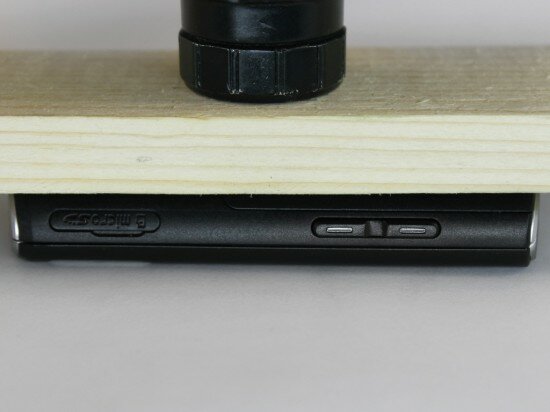
- Pic. 5. The phone under the 3 kg wooden bar
The grade is 24 from 24 possible
1.3 Bend test
We should say that a bend test and a squeeze test are similar because they feature the same qualities of a gadget. That is why the bend tests always follow the squeeze tests in our reviews. But in a bend test the pressure is not distributed all over the handset. It is concentrated in a particular part of the phone. That’s how it differs from a squeeze test. Actually we put the C3050 onto the two planks so that each edge of the phone lay on a plank. Then we hitched a string with 1 kg (2,2 lbs) load over the handset. Judging by picture 6 there was no bend. The device performed well after the test.
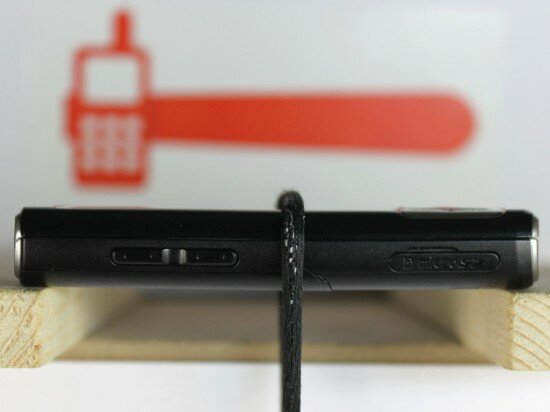
- Pic. 6. Bend test
The grade is 24 from 24 possible
1.4 Durability
We placed the gadget into a drum together with keys and pennies to simulate what might be happening in a man’s trouser pockets while carrying a phone for a long time (video 3). The drum was rotating for 5 min at the speed of 500 rpm. After the test we examined the C3050 and saw the scuffs on the steel cover of the keys (pic. 7). The screen glass got small cracks (pic. 8). Some scratches appeared on the lower and upper edges of the handset (pic. 9).
Video 3. Rotation of the drum
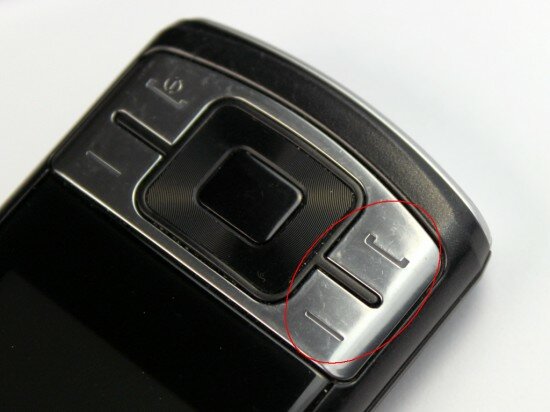
- Pic. 7. Damage of the steel cover of the keys

- Pic. 8. Damage of the screen glass

- Pic. 9. Scratches on the lower and upper edges
Anyway the grade is 15 from 15 possible
1.5 Scratch test
In order to test the quality of the material of which the Samsung C3050 is made we scratched the screen glass and the back panel at the force of 100 g (0,22 lbs). The nail did not damage the screen glass (video 4) – no scratch was left. But we managed to make a small scratch on the back cover. Fortunately it was hardly noticeable. For more information watch video 5.
Video 4. Screen scratching
The grade is 15 from 15 possible
Video 5. Scratching the back cover
The grade is 15 from 15 possible
1.6 High temperature
A cell phone that is left in the sun for a long time may face serious problems. Color rendering may become worse or the adhesive between the screen glass and the housing faceplate may melt etc. In this test we put the device in a metallic container 5 cm (1,968 inches) far from the electric bulb (40 Wt) to simulate what might be happening to the C3050 after laying in the sun for a long time. The bulb was heating the phone for 3 min. If you watch video 6 you’ll understand that the phone passed the test with no problem. It performed well afterwards. The adhesive between the screen glass and the housing faceplate did not melt.
Video 6. High temperature test
The grade is 12 from 12 possible
1.7 Dust test
Dust is a great threat for any handset, especially for a slide phone that is less dust resistant than a candy bar cell phone. If the space between the bearing elements is full of dust or sand it will be hard to slide the phone. Dust and grime may loosen the bearing elements and cause problems with the loop of the phone.
We took an enclosed tray with dust thrown in with the phone. Then we were vibrating it violently for 2 min. After the test we took the C3050 out and examined it (pic. 10). The back cover protected the battery from dust. There were no even small grains of dust under it (pic. 11). The charger jack and the ear-microphone jack are protected by caps. So there was also no dust inside (pic. 12).
However we heard an unpleasant noise when the phone slid. It proved that some grains of dust penetrated into the slide mechanism. Soon the gadget stopped making this noise.

- Pic. 10. The phone after the test
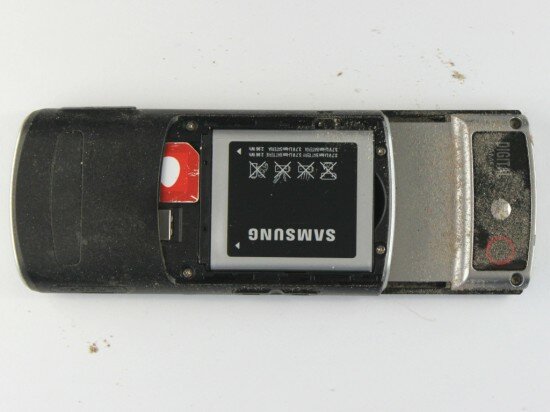
- Pic. 11. Dust under the back cover

- Pic. 12. No dust inside the ear-microphone jack
The grade is 12 from 12 possible
1.8 Connectivity
A mobile phone is used not only for listening to music or taking pictures but also for making calls. This is the main function of any phone. In this test we found out how the Samsung C3050 can receive calls when the level of coverage is poor.
We put the handset into a box. Then we foiled the box (the foil served as a shield) and made a 45 x 40 mm ( 1,77 x 1,57 inches) hole in it (video 7). When we made a call the indicator showed that the signal reception was changing all the time (from 2 points to maximum 6 points). In spite of this fact the phone received all the calls.
Video 7. Connectivity test
The grade is 15 from 15 possible
After the 1st stage of the stress test the Samsung C3050 got 192 (from possible 192)
2. Samsung C3050 stress test. Stage 2 – Tough conditions
2.1 Drop test
At the second stage of the drop test the height of the fall on the carpet was 1,5 m (4,9 ft) and the height of the fall on the tiles was 50 cm (1,64 ft). When the phone fell on the carpet nothing bad happened. The cover was in its proper place (video 8). When the phone fell on the tiles the result was the same: no damage, full survival (video 9).
Video 8. Drop on the carpet from 1,5 m (4,9 ft)
Video 9. Drop on the tiles 50 cm (1,64 ft)
The grade for the drop on the carpet is 30 from possible 30
The grade for the drop on the tiles is 30 from possible 30
2.2 Squeeze test
In this stage of the test we increased the applied pressure to 10 kg (22 lbs). But it was not enough to damage the gadget. The C3050 survived with no problem.
The grade is 24 from 24 possible
2.3 Bend test
We increased the weight of the load to 5kg (11 lbs). The result was the same as in the previous stage of this test. The gadget performed perfectly afterwards.
The grade is 24 from 24 possible
2.4 Durability
In the result of the 1st stage of this test the look of the housing faceplate became worse but the back cover was as new. In this test we increased the time the phone spent in the rotating drum to 10 min. The steel cover of the keys got more scuffs (pic. 13). There were also more cracks on the screen. Some of them were quite noticeable (pic. 14). The back cover still looked almost perfect.
We could see some small scratches but they did not strike the eye. However we were disappointed with the upper and lower edges of the handset: the grey paint was scuffed and a plastic material was clearly seen under it in some places (pic. 16).
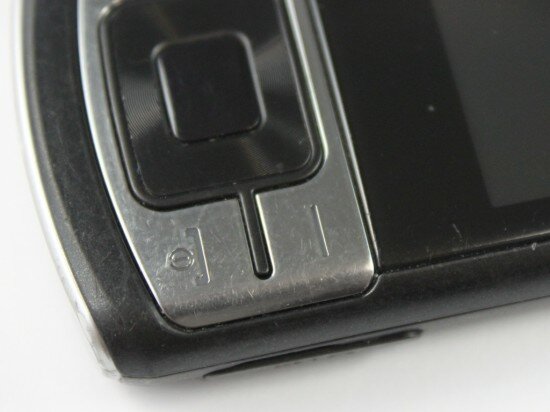
Pic. 13. Damage of the keys
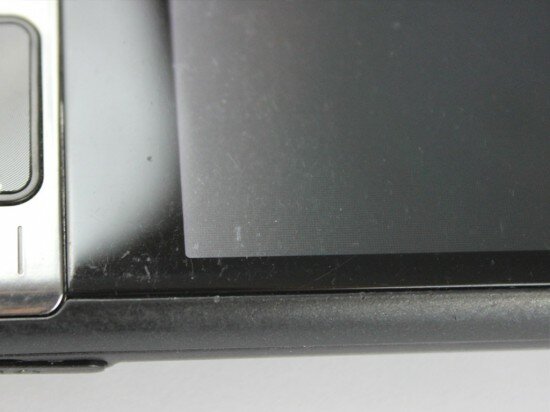
Pic. 14. Cracks on the screen

Pic. 15. Small scratches on the back cover
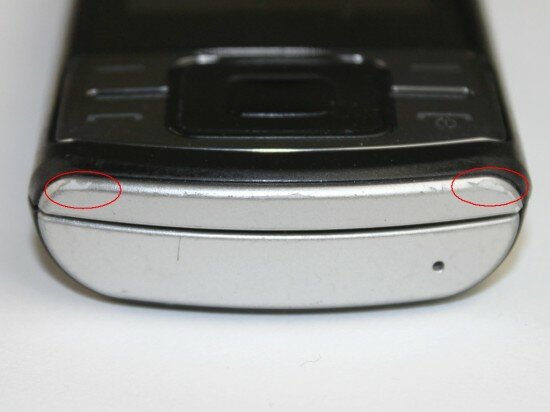
Pic. 16. Scratches at the edges
The grade is 10 from 15 possible
2.5 Scratch test
In this stage of the test we increased the force of scratching to 300 g (0,66 lbs) and we managed to make a scratch on the screen. It was not deep but the display was not clear any more. We also made a deep and quite noticeable scratch on the back cover.
The screen gets 10 points from 15 possible
The back cover gets 10 points from 15 possible
2.6 Freeze test
Freezing temperatures can not cause a serious damage to a cell phone but the may have a bad impact on its performance. In low temperatures, for example, a battery becomes low too fast and a display may glitch. We put the C3050 in a freezer for 2 hours (pic. 19). The temperature was -15 °C (5 °F). The phone was in the speaking mode. After the test we examined our device (video 10). It performed with no problem. The display did not glitch. All the keys functioned perfectly. However the battery capacity was half empty and that is not a good result.
Video 10. Freeze test
The grade is 12 from 18 possible
2.7 High temperature
After the C3050 spent 5 min. Under the electric bulb we took it out and saw that it was switched off (video 11). However the phone was not damaged and performed with no problem when we switched it on. The keys functioned well.
Video 11. High temperature test
The grade is 12 from 12 possible
2.8 Immersion in water
Everybody knows that all electrical appliances should be kept away from water. We decided to check how waterproof the Samsung is. So we dunked the phone under water for 1 second (video 12). Then we took off the back cover and saw no drops of water under it. The charger jack and the ear-microphone jack were protected by caps and water did not penetrate there. The gadget looked as if it had not been under water. However the sound from the loudspeaker was not so loud but soon it became normal again after we dried the C3050.
Video 12. Immersion in water for a sec
The grade is 30 from 30 possible
2.9 Dust test
In this test we were vibrating the enclosed tray with dust thrown in with the phone for 5 min. When the experiment was over we took the gadget out and examined it carefully. This time there was more dust between the slidable frame and the stationary frame. The seams between the keys were also full of dust (pic. 17) and it was very difficult to get rid of the small grains of dust that had penetrated there. The back cover performed its main function and protected the battery from dust.
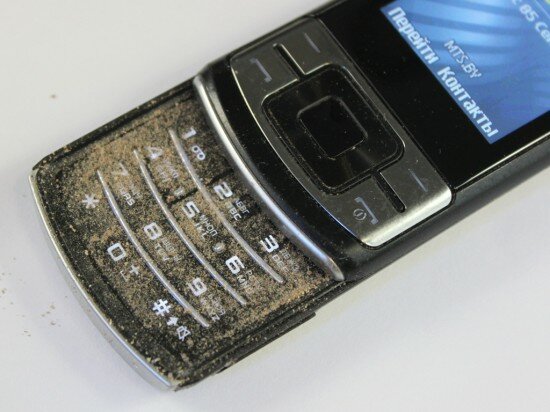
Pic. 17. The phone after the test
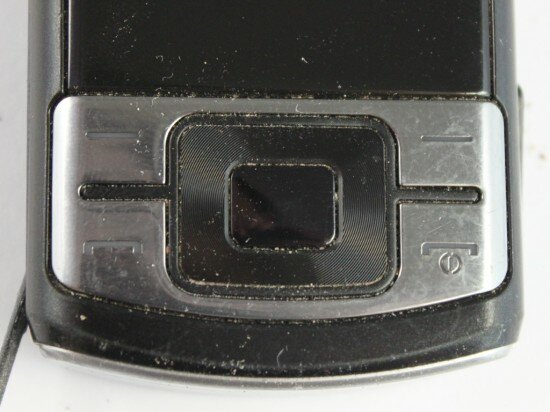
Pic. 18. Grains of dust in the seams between the keys
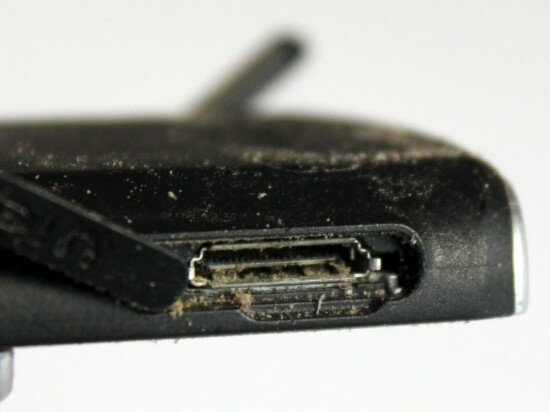
Pic. 19. Dust in the charger jack
The grade is 12 from 12 possible
2.10 Connectivity
The level of coverage was much worse than in the previous stage of this test. We put the handset in a new box (covered with foil) and made a 20 x 20 mm (0,787 x 0,787 inches) in it. When we made a call the indicator showed that the signal reception was changing from 1 to 2 points. But the phone received all the calls with no problems. For more information watch video 13.
Video. 13 Connectivity test
The grade is 10 from 15 possible
After the 2nd stage of the stress test the Samsung C3050 got 214 (from possible 240)
3. Samsung C3050 stress test. Stage 3 – The toughest conditions
3.1 Drop test
At the last stage of the stress test we dropped the phone on the carpet from 2 m (6,56 ft) and on the tiles from 1 m (3,28 ft) (video 14, 15). The back cover did not shift when the device fell on the carpet. However the battery fell out when the gadget hit the tiles. After the test the handset did not slide well: the slidable frame and the stationary frame were loosened.
Video. 14 Drop on the carpet from 2 m (6,56 ft)
The grade is 30 from 30 possible
Video. 15. Drop on the tiles from 1 m (3,28 ft)
The grade is 20 from 30 possible
3.2 Squeeze test
In this test we increased the applied pressure to 20 kg (44 lbs). We heard an unpleasant noise when we applied the pressure. It was caused by the grains of dust and sand between the bearing elements of the slide mechanism. But the phone survived with no problem.
The grade is 24 from 24 possible
3.3 Bend test
The 10 kg (22 lbs) load made a significant bend (pic. 20, video 16). But the gadget performed well after the test. The screen, the slide mechanism – everything was safe.
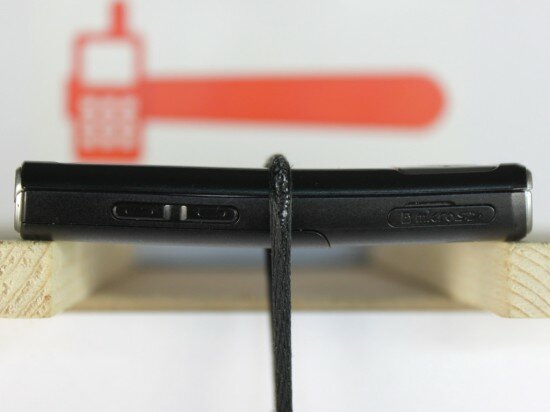
Pic. 20. Bend caused by the 10 kg (22 lbs) load
Video 16. Bend test. The applied pressure is 10 kg (22 lbs)
The grade is 24 from 24 possible
3.4 Durability
In the last stage of this experiment the drum was rotating for 20 min. In the result of the test some small grains of dust penetrated under the screen glass (the matter is that before this test the phone laid under the electric bulb that heated the screen very much and deformed the glass). Small plastic pieces that appeared in the result of the drum rotation penetrated under the deformed screen glass.
The display was not so clear as before (pic. 21). There were more cracks on the screen glass and some deep scratches spoiled the picture. All this damage could be seen with the naked eye (pic. 22). More scuffs and scratches appeared on the steel cover of the keys. The keys did not look smart any more. Surprisingly the back cover was almost perfect. We do not mean that it was not damaged at all. But it seemed that all the scuffs, cracks and scratches were made on purpose by the designers in order to add some individual features to the phone (pic. 24). There were two times more scratches on the grey paint of the upper and lower edges than after the similar test in the second stage (pic. 25).
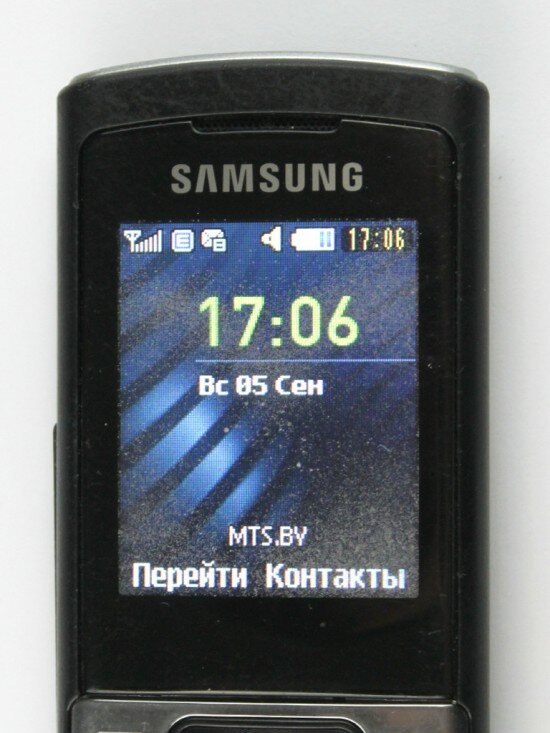
Pic. 21. Dust under the screen glass

Pic. 22. Damage of the screen glass
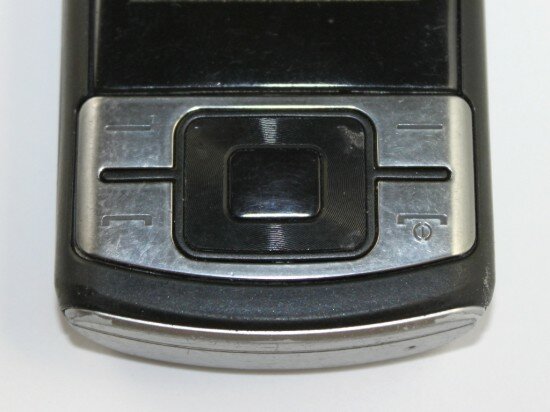
Pic. 23. Damage of the keys

Pic. 24. The back cover was not damaged

Pic. 25. Damage of the lower edge
The grade is 10 from 15 possible
3.5 Scratch test
This time the the force of scratching was 600 g (1,322 lbs) (video 17, 18). We managed to make two deep scratches on the screen and on the back cover (pic. 26, 27).
Video 17. Screen scratching
Video 18. Scratching of the back cover

Pic. 26. Scratches on the screen
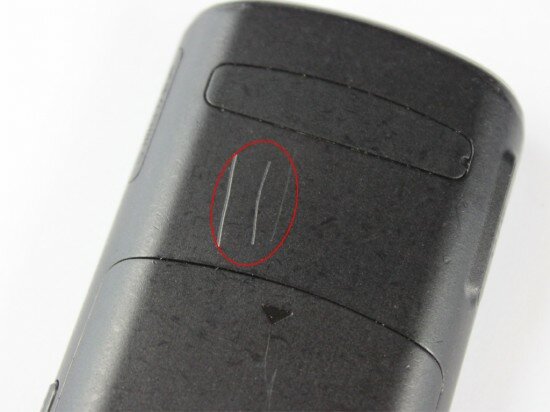
Pic. 27. Scratches on the back cover
10 points (from 15 possible) for the screen
10 points (from 15 possible) for the back cover
3.6 High temperature
We increased the time of this test to 10 min. After the experiment was over we took the phone out and examined it carefully (video 19). The display went blank in front of our eyes. But the keypad produced the sound when we pressed it. So the phone was not switched off – it worked. The screen glass was a bit deformed by the high temperature. When we cooled it down the display became normal. The phone performed with no problem.
Video 19. High temperature test
The grade is 8 from 12 possible
3.7 Immersion in water
In this test we dunked the device under water for 1 sec. (video 20) and it survived. The keys worked well, no water penetrated into the charger jack and the ear-microphone jack. Even the sound out of the loudspeaker was loud. However much water penetrated under the back cover. That was the main difference from the previous test (pic. 28).
Video 20. Immersion in water
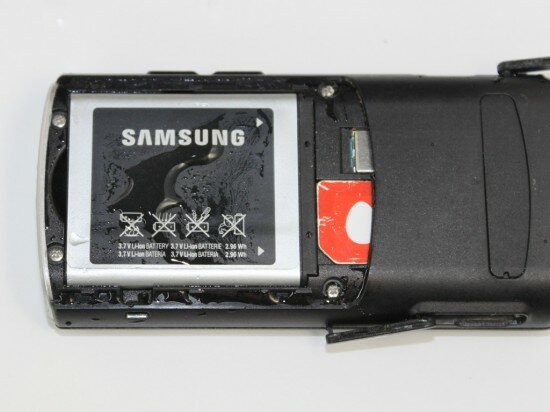
Pic. 28. Water under the back cover
The grade is 30 from 30 possible
3.8 Immersion in beer
Except immersions in water we always test gadgets in beer. It’s true that people rarely drop their devices in a glass of beer but anyway we think that this is possible. So we dunked the Samsung C3050 under beer for 10 sec. (video 21). Beer penetrated into the ear-microphone jack but it did not cause any damage to the phone (pic. 29).
Video 21. Immersion in beer
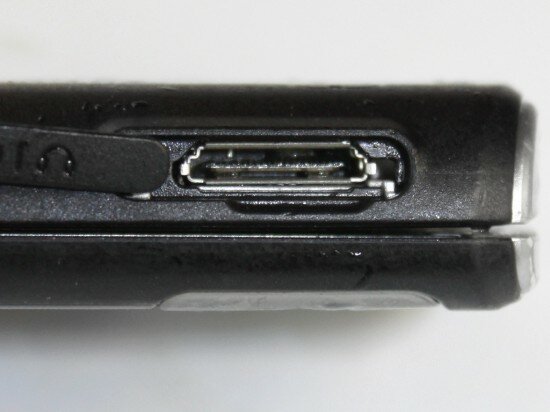
Pic. 29. Beer penetrated into the ear-microphone jack
The grade is 9 from 9 possible
3.9 Dust test
We increased the time of this test to 10 min. As we thought dust penetrated under the screen glass that was deformed by the high temperature (pic. 30). Sometimes the keys of the navigational key unit failed to perform when we pressed them. There was a lot of dust and sand in the seams of the keypad and it produced an unpleasant noise when we dialed a phone number. It was more difficult to press the lower row of the keypad than the other keys. There was some grime between the bearing elements and the phone did not slid well. Moreover we heard that unpleasant noise out of the slide mechanism caused by the grains of dust and sand. In order to get rid of the dust and grime we had to disassemble the device.
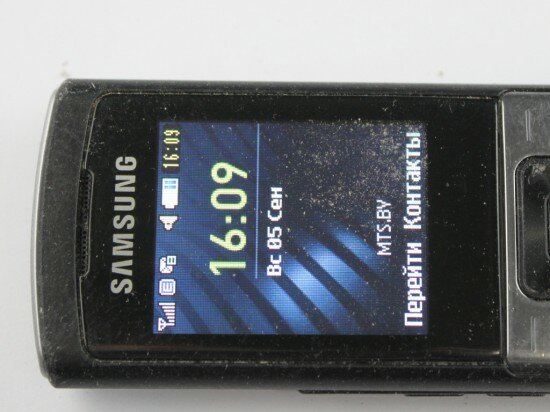
Pic. 30. Dust under the screen glass
The grade is 8 from 12 possible
3.10 The keypad
The buttons at the edges of Samsung C3050 are waterproof and dustproof. After all the tests they functioned with no problem. The keypad also worked but there was a lot of dust under it. The navigational key unit is a weak part of the phone because it did not pass the dust test and the keys failed to work from time to time. But we managed to solve this problem before we disassembled the gadget. We just bumped it slightly and shook out all the dust.
The grade is 20 from 20 possible
3.11 Connectivity
We put the handset in a new box (covered with foil) and made a 15 x 15 mm (0,59 x 0,59 inches) hole in it. When we made a call the indicator showed that the level of signal reception was reduced to zero (video 22). Surprisingly the phone received all 10 calls that we made.
Video 22. Connectivity test
The grade is 10 from 15 possible
3.12 Short circuit and overcharge
At first we made a 1 second short circuit of the battery charger. Watch video 23 to be sure that the battery charger survived with no problem.
Video 23. Short circuit of the battery charger
The grade is 15 from 15 possible
It is a widely known fact that there is a board inside a cell phone battery. The board is connected to a cell and protects it from a short circuit. However we made a 1 second short circuit of the battery with the help of forceps in order to check how well protected it is (video 24). The battery survived. It did not even discharge.
Video 24. Short circuit of the battery
The grade is 15 from 15 possible
Then we discovered what would happen to the phone if the level of charging voltage was changed from maximum to minimum. Therefore we plugged the battery charger in the PSU and in the charger jack (video 25). The nominal charging voltage was 5 V. Then we were gradually decreasing the voltage. As a rule the phone should have stopped charging when the level of voltage was 4 – 4,2 V. But it happened only when the voltage was less than 2 V. Evidently this is a disadvantage of the Samsung C3050. But it’s not a vital problem. Then we were gradually increasing the voltage to 8 V. We had almost managed to reach this maximum while the phone stopped charging – the protection system of the gadget performed its function. So the phone passed the overcharge test but showed bad results when there was lack of charging.
Video 25. Charging
The grade is 10 from 15 possible
At last we carried out the toughest test for the Samsung C3050 – power supply excess. We took the battery out and plugged the PSU in the phone. But at first we decided to decrease the energy supply in order to know the reaction of the phone to the lack of power. At a certain point the device warned us that the battery was empty and switched off (video 25).
Then we switched on the handset and started increasing the energy supply. When we reached 6 V the phone started consuming more and more power and this consumption was growing with the increase of energy supply. When we reached 6,5 V the C3050 glitched and the display went dark. But we did not stop our experiment and switched it on. We decided to reach our aim – to increase the energy supply to 7 V. And we did it. But the gadget could not cope with it. The PSU warned us that its protection system worked because of a short circuit. It usually happens when a circuit board of a phone is damaged. It was true. We could not switch on the device.
To our great surprise the phone started to work again when we made an attempt to switch it on some time later. The performance was perfect as if there had not been a short circuit.
Video 26. Power supply excess
The grade is 10 from 15 possible
3.13 Disassembling
At the end of the test we disassembled the device (pic. 31). Inside it was the same as all the other Samsung slide phones. Such arrangement of electronic components is time-proved as dozens of the other handsets produced earlier have the same interior design.
Some small pieces of metal stuck to the cover that protected the acoustic radiator of the loudspeaker. The cover prevented the grains of dust and steel penetrate inside (pic. 32). So the sound quality was good throughout all the test. The chip responsible for vibrate ring and the loudspeaker are soldered to the upper part of the circuit board. It makes it more difficult and expensive to replace them.
The circuit board is not a novelty. But it had a compact design. There is little empty space and all the important chips are encapsulated by compound (pic. 33). The charger jack and the ear-microphone jack are installed in the circuit board and it is quite difficult to repair or replace them. It should be noted that mechanical components of a cell phone are often damaged while using a gadget.

Pic. 31. The phone disassembled
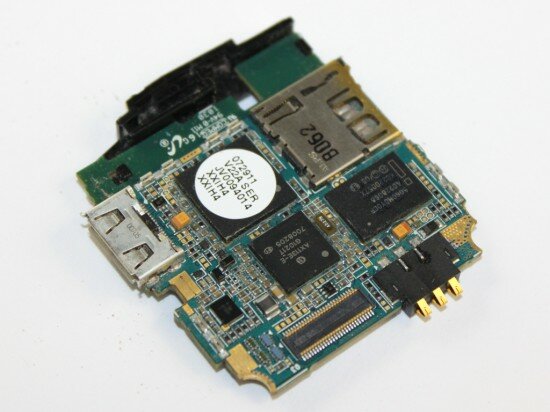
Pic. 32. Small pieces of metal and dust on the cover of the loudspeaker
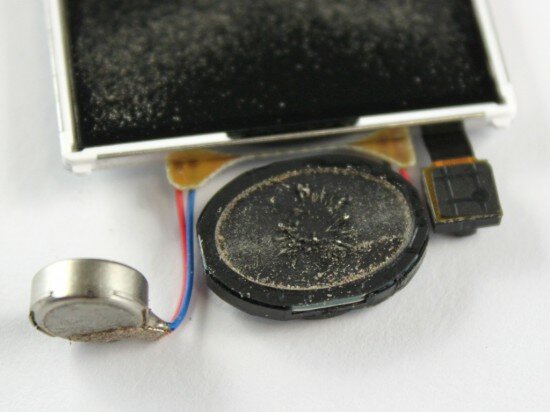
Pic. 33. The circuit board
The grade is 20 from 20 possible
The grade for the 3rd stage of the stress test is 283 (from possible 351)
Conclusion:
Samsung C3050 is not a very ruggedized cell phone. But we did not expect it to be as it is a low-cost device. The handset passed the drop test successfully and performed with no problem after the immersion in water and in beer. However the gadget showed bad results when we overcharged it and exceeded power supply. So the grade for these tests was not perfect. Dust that penetrated under the navigational key unit caused problems with its performance which is a rare case. As for the other tests we can not say that the Samsung C3050 passed them better than the other gadgets that we experienced to abuse. But it is very far from being the worst cell phone that we have ever tested. The look of the Samsung C3050 after the stres test (pic. 34, 35).
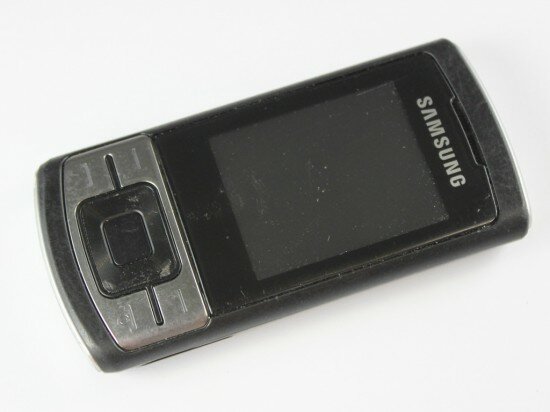
Pic. 34. The front of the phone after the test
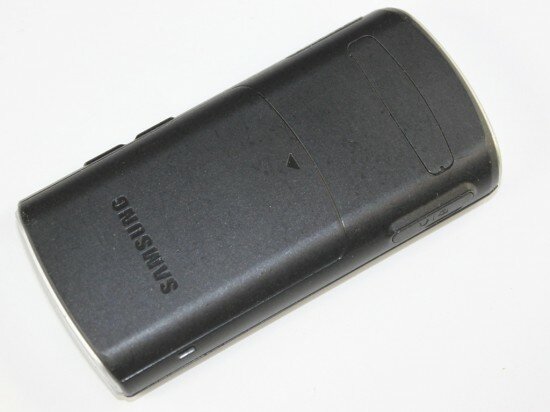
Pic. 35. The back of the phone after the test

 Russian version
Russian version